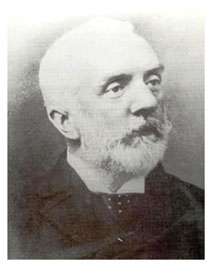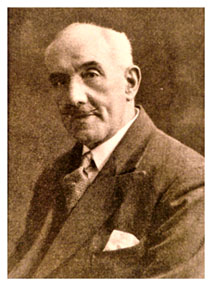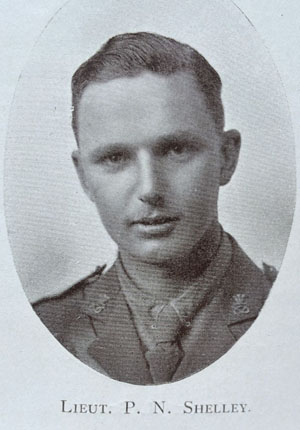

 The Shelley family's pottery story began in the 18thC when Randle Shelley and his sons Thomas and Michael
bought land in Longton, built a pottery and began producing plates and dishes. Michael was an important local figure, a member of the Chamber of Commerce and churchwarden.
Later some of their pottery buildings would become part of the Gladstone pottery.
The Shelley family's pottery story began in the 18thC when Randle Shelley and his sons Thomas and Michael
bought land in Longton, built a pottery and began producing plates and dishes. Michael was an important local figure, a member of the Chamber of Commerce and churchwarden.
Later some of their pottery buildings would become part of the Gladstone pottery.
 Two further generations of the family were potters and then in 1862 Joseph Ball Shelley joined Henry Wileman
at Foley China as a traveller after a second factory had been built to make fine bone china. Joseph became a partner in 1872 when the pottery became Wileman & Co and
Joseph's son Percy also joined the business in 1881.
By 1896 Joseph had died so Percy took control and worked to improve the business.
Two further generations of the family were potters and then in 1862 Joseph Ball Shelley joined Henry Wileman
at Foley China as a traveller after a second factory had been built to make fine bone china. Joseph became a partner in 1872 when the pottery became Wileman & Co and
Joseph's son Percy also joined the business in 1881.
By 1896 Joseph had died so Percy took control and worked to improve the business.

Joseph B Shelley

Wileman China 1884

Percy Shelley 1869 - 1937
 Joseph's son, Percy Shelley, joined his father at Wileman and initially worked to improve the ware and understand the global market.
In 1893 he attended the Chicago exhibition in order to better understand the American export market.
Joseph's son, Percy Shelley, joined his father at Wileman and initially worked to improve the ware and understand the global market.
In 1893 he attended the Chicago exhibition in order to better understand the American export market.
 Among the early designers for the company were Rowland Morris and Frederick Rhead.
Morris famous for his "Dainty" shape and Rhead famous for his "Intarsio" design among many others.
Among the early designers for the company were Rowland Morris and Frederick Rhead.
Morris famous for his "Dainty" shape and Rhead famous for his "Intarsio" design among many others.

"Intarsio" design by Frederick Rhead

Soda Syphon(No 502) Model of a German mine(No 188)
 The production of commemorative and view ware began at the factory before 1900 and crest china from 1903 in white china.
Their crested china shown at the 1920 British Industries Fair included souvenirs of the Great War as well as novelty items.
The production of commemorative and view ware began at the factory before 1900 and crest china from 1903 in white china.
Their crested china shown at the 1920 British Industries Fair included souvenirs of the Great War as well as novelty items.
 In 1890 Percy Shelley married Emma Mayer and they lived in Dresden near Queen's Park.
Their son Percy Norman was born in 1893 followed by twins Vincent Bob and Kenneth Jack in 1895.
Percy Shelley was an ardent Liberal and became chairman of the North Staffordshire Liberal Federation for many years as well as being a
campaigner for better conditions in the pottery industry.
He was also one of the main architects of the Federation of the Six Towns resulting in the formation of the city of Stoke on Trent in 1925.
In 1890 Percy Shelley married Emma Mayer and they lived in Dresden near Queen's Park.
Their son Percy Norman was born in 1893 followed by twins Vincent Bob and Kenneth Jack in 1895.
Percy Shelley was an ardent Liberal and became chairman of the North Staffordshire Liberal Federation for many years as well as being a
campaigner for better conditions in the pottery industry.
He was also one of the main architects of the Federation of the Six Towns resulting in the formation of the city of Stoke on Trent in 1925.

Wileman & Co advertising Shelley china 1920
 In the early years of the 20thC Shelley employed many designers at the factory including Walter Slater (art director),
Hilda Cowham - known for "Playtime" and
Mabel Lucie Attwell who designed the Boo Boo series as well as figures and various designs for children.
In the early years of the 20thC Shelley employed many designers at the factory including Walter Slater (art director),
Hilda Cowham - known for "Playtime" and
Mabel Lucie Attwell who designed the Boo Boo series as well as figures and various designs for children.

Advertisement for nursery ware designed by Hilda Cowham circa 1926

Nursery ware designed by Mabel Lucie Attwell

Figurines designed by Mabel Lucy Attwell, the one on the left, The Golfer (LA8), on the right, Mermaid (LA31)
 Walter Slater arrived in 1905 and replaced Frederick Rhead as Art Director.
He had experience of having worked at Minton and at Royal Doulton where he'd worked under his uncle, John Slater.
Walter Slater arrived in 1905 and replaced Frederick Rhead as Art Director.
He had experience of having worked at Minton and at Royal Doulton where he'd worked under his uncle, John Slater.

Walter Slater
 Walter Slater lustre ware vases produced in the early 1920s,
the vase on the left is the Mikado design showing a Geisha girl in traditional costume. The vase on the right is the Carp design in pale green and pink lustre.
Walter Slater lustre ware vases produced in the early 1920s,
the vase on the left is the Mikado design showing a Geisha girl in traditional costume. The vase on the right is the Carp design in pale green and pink lustre.

Walter Slater Lustre Vases

Eric Slater
 Eric Slater joined his father Walter in the design department in 1919 and he became art director on
Walter's retirement in 1937.
Eric Slater joined his father Walter in the design department in 1919 and he became art director on
Walter's retirement in 1937.
 During WW1 both (Percy) Norman and (Vincent) Bob Shelley left Stoke to serve in the army in France and Flanders.
Norman came home when the war ended and returned to look after production at the Shelley factory, Bob was a prisoner of war until late 1918
and finally came home where he joined his brothers at the family business and took over charge of the warehouses.
During WW1 both (Percy) Norman and (Vincent) Bob Shelley left Stoke to serve in the army in France and Flanders.
Norman came home when the war ended and returned to look after production at the Shelley factory, Bob was a prisoner of war until late 1918
and finally came home where he joined his brothers at the family business and took over charge of the warehouses.
He lived on Chase Lane, Tittensor

Norman Shelley in his uniform of the 4th Battalion North Staffs regiment WW1

Jack and Eileen, Bob and Doris at their wedding in 1923
 Jack Shelley studied Commerce at university and joined the business in 1918 where he concentrated on the advertising and finances.
All three brothers were known by their middle name, Mr Norman, Mr Bob, and Mr Jack. Each brother also had a cup shape named after them, Norman, Vincent, and Kenneth.
In 1923 (Vincent) Bob Shelley married Doris Hammersley and his twin brother (Kenneth) Jack married her friend Eileen Nelson at a joint wedding.
Their father Percy had two identical houses built for the newlyweds on Barlaston Old Road in Trentham
Jack Shelley studied Commerce at university and joined the business in 1918 where he concentrated on the advertising and finances.
All three brothers were known by their middle name, Mr Norman, Mr Bob, and Mr Jack. Each brother also had a cup shape named after them, Norman, Vincent, and Kenneth.
In 1923 (Vincent) Bob Shelley married Doris Hammersley and his twin brother (Kenneth) Jack married her friend Eileen Nelson at a joint wedding.
Their father Percy had two identical houses built for the newlyweds on Barlaston Old Road in Trentham
 After a few more years as Foley China the company's name changed in the mid-1920s to Shelley.
After a few more years as Foley China the company's name changed in the mid-1920s to Shelley.

"Shelley Girl" made for advertising in the 1920s

Left to right - Bob, Jack, Percy and Norman Shelley
 In 1929 it became a limited company known as Shelley Potteries Ltd with the three sons joining their father.
In 1929 it became a limited company known as Shelley Potteries Ltd with the three sons joining their father.

1930s Advertisement for Shelley China

Shelley "Vogue" shape 1930s

Shelley "Queen Anne" shape - tea set 1930s
 In 1932 Percy retired and his sons Norman, Bob and Jack took over the business.
In 1932 Percy retired and his sons Norman, Bob and Jack took over the business.
 In 1933 Jack was admitted to hospital for an operation but died at the age of only 38.
His widow and daughters June and Faye later moved away from Trentham.
In 1933 Jack was admitted to hospital for an operation but died at the age of only 38.
His widow and daughters June and Faye later moved away from Trentham.
 During WW2 production of English
china was cut back but Shelley China could still produce ware for their flourishing export business
and their reputation abroad began to grow. Pottery companies were amalgamated and granted nucleus certificates: only companies with these certificates
were allowed to produce pottery.
Shelley's were granted a certificate and were joined at the works by Jackson and Gosling whose trademark was "Grosvenor China" a company owned by Copeland.
During WW2 production of English
china was cut back but Shelley China could still produce ware for their flourishing export business
and their reputation abroad began to grow. Pottery companies were amalgamated and granted nucleus certificates: only companies with these certificates
were allowed to produce pottery.
Shelley's were granted a certificate and were joined at the works by Jackson and Gosling whose trademark was "Grosvenor China" a company owned by Copeland.
 At the start of WW2 Eric Slater joined the Home Guard.
At the start of WW2 Eric Slater joined the Home Guard.
 In 1940 Bob Shelley became Commanding Officer of the 3rd Staffordshire (Longton) Battalion of the
Home Guard with the rank of Lt. Colonel. Bob arranged for a mug to be made at the factory for each member of his battalion.
He saw the end of the war but died of a heart attack in December 1945 leaving brother Norman as sole director.
In 1940 Bob Shelley became Commanding Officer of the 3rd Staffordshire (Longton) Battalion of the
Home Guard with the rank of Lt. Colonel. Bob arranged for a mug to be made at the factory for each member of his battalion.
He saw the end of the war but died of a heart attack in December 1945 leaving brother Norman as sole director.

Bob in his uniform as Lt. Colonel of the 3rd Staffordshire (Longton) Battalion

Advertisement for Shelley Fine Bone China dated 1956
 In January 1946 art director Eric Slater and sales manager Ralph Tatton were both elected to the Board of Directors.
In January 1946 art director Eric Slater and sales manager Ralph Tatton were both elected to the Board of Directors.

Painting of the Shelley factory, as it was c1950, done in 2011 by Ray Reynolds for the Shelley Group. Ray was the decorating manager from 1955 until the takeover in 1966. (family collection)

Ray Reynolds
 Shelley china was displayed at the 1951 Festival of Britain including these designs by Eric Slater.
Shelley china was displayed at the 1951 Festival of Britain including these designs by Eric Slater.


Bob with Alan and Jill
 Bob and Doris had two sons, Alan b 1925 and Donald b 1927 and a daughter (Margaret) Jill b 1932.
Bob and Doris had two sons, Alan b 1925 and Donald b 1927 and a daughter (Margaret) Jill b 1932.
 Decorating Shop floor at Shelley factory, early 1950s.
Decorating Shop floor at Shelley factory, early 1950s.


Alan Shelley
 After spending the later part of WW2 in the Royal Navy Alan joined Shelley China as Sales Director in 1946.
He married Susan Whitfield and had three children.
In 1965 Alan became the second member of the Shelley family to attend a trade fair in the USA.
After spending the later part of WW2 in the Royal Navy Alan joined Shelley China as Sales Director in 1946.
He married Susan Whitfield and had three children.
In 1965 Alan became the second member of the Shelley family to attend a trade fair in the USA.
 Donald Shelley married Valerie Wilson in 1955 and they lived with their four children at Oulton.
He joined Shelley China in 1948 with a Natural Sciences degree, he developed a cup casting machine and
"Top Hat" electric kilns and in 1956 Shelley Electric Furnaces Ltd was formed under his leadership.
Donald Shelley married Valerie Wilson in 1955 and they lived with their four children at Oulton.
He joined Shelley China in 1948 with a Natural Sciences degree, he developed a cup casting machine and
"Top Hat" electric kilns and in 1956 Shelley Electric Furnaces Ltd was formed under his leadership.

Donald Shelley b1927

The coffee cup and saucer on the left is pattern number 2366, pattern name 'Serenity and Grey Crystals, the cup shape is the Stirling shape. The trio on the right is pattern number 13587, pattern name Primrose Chintz, the cup shape is the Henley shape.
 1957 saw the last of the coal fired bottle ovens and all became electric.
1957 saw the last of the coal fired bottle ovens and all became electric.
 In 1966 Shelley China was taken over by Allied English Potteries and the factory was used to produce Royal Albert bone china.
In 1966 Shelley China was taken over by Allied English Potteries and the factory was used to produce Royal Albert bone china.
 In 1971 it became part of the Royal Doulton group.
In 1971 it became part of the Royal Doulton group.
Many thanks to members of the Shelley family and to Chris Davenport of the Shelley Group for their help with this profile.
You can find out more at www.shelley.co.uk